Having left California the day before, we packed up our campsite at Humbug Mountain and drove north, following Highway 101 along Oregon’s coast. We checked our tide pool schedule and aimed to arrive in the Bandon State Park area for low tide.
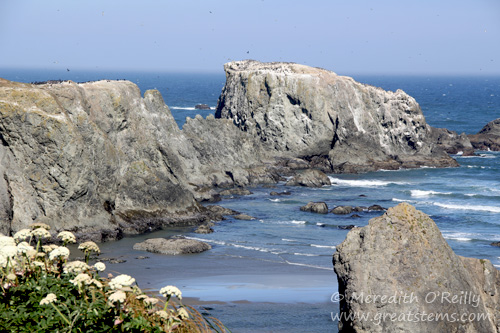 It is so nice being on vacation with only a minimal schedule to follow. Until that morning, we’d never heard of Bandon State Park, yet there we were, and it was blue and beautiful. I’ll admit, however, that it was also very chilly and very windy. We actually broke out socks (which we wore ever so attractively with our Keens) and added long-sleeved shirts under our jackets.
It is so nice being on vacation with only a minimal schedule to follow. Until that morning, we’d never heard of Bandon State Park, yet there we were, and it was blue and beautiful. I’ll admit, however, that it was also very chilly and very windy. We actually broke out socks (which we wore ever so attractively with our Keens) and added long-sleeved shirts under our jackets.
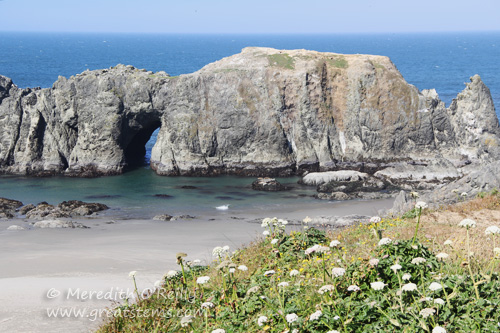
Do you see that first large rock to the right of the arch? Take note — there are harbor seals there, and you’ll see them again shortly.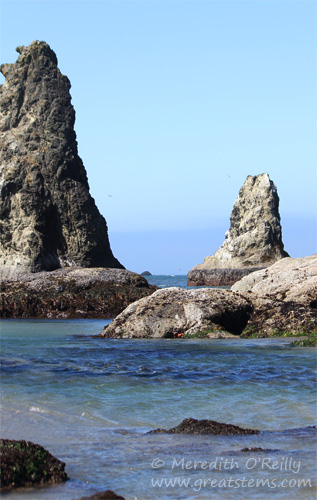
The tide was still in the process of receding when we first arrived. Above, you can see the high tide line on the rock farthest back. Somewhat closer in, the bright orange color of an ochre sea star stands out.
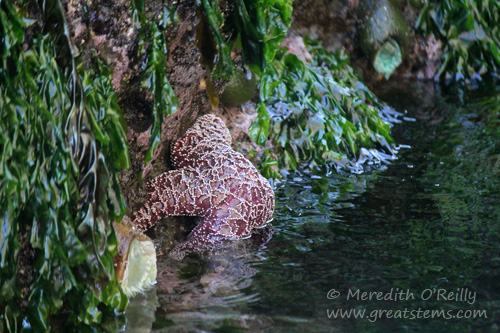
The presence of ochre sea stars is considered an indication of a healthy ecosystem.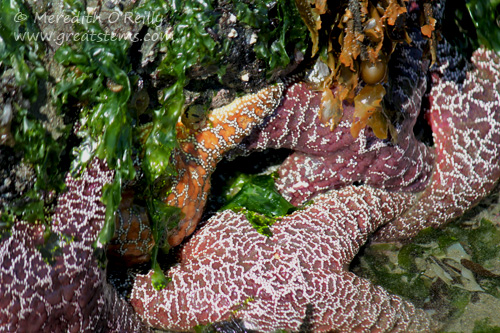
On the rocks at Bandon, there were many ochre sea stars, both solitary and in groups. These sea stars are typically purple but are sometimes orange.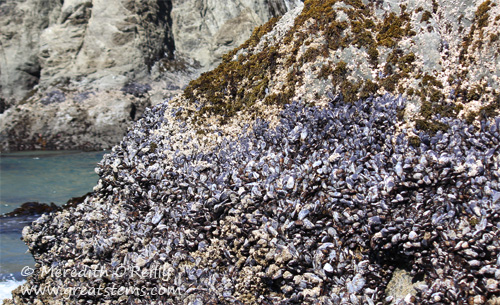 Where there were sea stars, the mussel population was very much in control. This rock, close to the beach, shows how mussels can form massive aggregations when sea stars aren’t around. Mussels often dominate rocks between high and mid tide levels, but this rock was excessively covered, even in the lower areas where sea stars should have been happily feasting. I wonder if this rock is too close to easy human access and destruction — could this be why there weren’t any sea stars there to counter the imbalance?
Where there were sea stars, the mussel population was very much in control. This rock, close to the beach, shows how mussels can form massive aggregations when sea stars aren’t around. Mussels often dominate rocks between high and mid tide levels, but this rock was excessively covered, even in the lower areas where sea stars should have been happily feasting. I wonder if this rock is too close to easy human access and destruction — could this be why there weren’t any sea stars there to counter the imbalance? 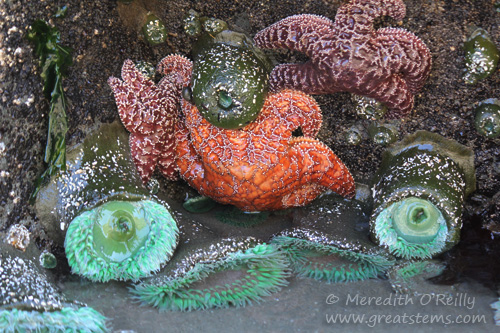
On other rocks, sea stars and anemones shared prime real estate. Note how large the orange ochre is.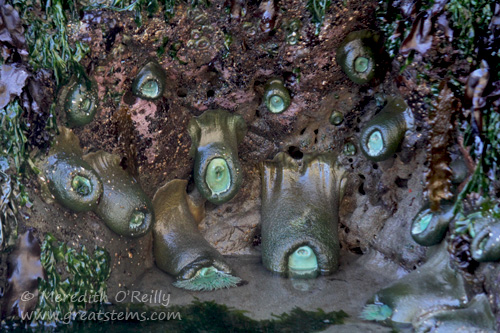 On yet another rock, these sea anemones were drooping so much as the water receded, they gave the appearance of melting.
On yet another rock, these sea anemones were drooping so much as the water receded, they gave the appearance of melting.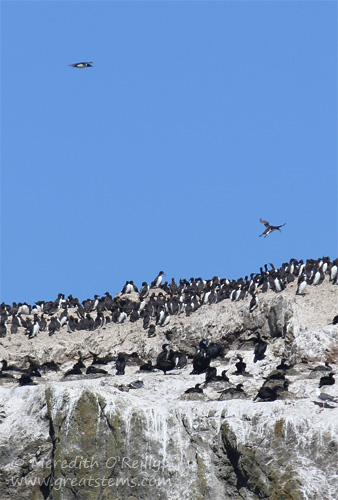 Far above the water, large colonies of Common Murres, also called Common Guillemots, nested at the top of the massive rocks. Normally, these birds spend most of their lives at sea. But they come to shore to breed. The parents don’t build nests up there — they incubate their single egg directly on the rock. Common Murres’ take-offs and flights are awkward; they are much better divers than flyers.
Far above the water, large colonies of Common Murres, also called Common Guillemots, nested at the top of the massive rocks. Normally, these birds spend most of their lives at sea. But they come to shore to breed. The parents don’t build nests up there — they incubate their single egg directly on the rock. Common Murres’ take-offs and flights are awkward; they are much better divers than flyers.
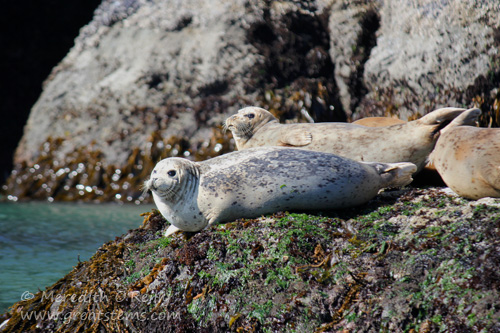 As I mentioned earlier, a small group of harbor seals was hauled out on one of the rocks not far from the big arched rock. Because they were fairly close to shore, we kept our distance and moved slowly and quietly, trying to disturb the seals as little as possible. But other people were not so thoughtful. They went across the low water and trampled across rocks to get closer to these seals, who were very alarmed at their presence. It isn’t easy for these seals to get on the rocks — they do so when the water is higher, then they rest on the rocks in the sun while the tide is low. The front seals you see in this picture were driven away shortly thereafter by the people who kept trying to get close, and that meant those seals likely had to try to rest in the cold water or expend a lot of energy swimming, if they weren’t able to find another rock to haul out on. There are laws against the actions of those careless, selfish people.
As I mentioned earlier, a small group of harbor seals was hauled out on one of the rocks not far from the big arched rock. Because they were fairly close to shore, we kept our distance and moved slowly and quietly, trying to disturb the seals as little as possible. But other people were not so thoughtful. They went across the low water and trampled across rocks to get closer to these seals, who were very alarmed at their presence. It isn’t easy for these seals to get on the rocks — they do so when the water is higher, then they rest on the rocks in the sun while the tide is low. The front seals you see in this picture were driven away shortly thereafter by the people who kept trying to get close, and that meant those seals likely had to try to rest in the cold water or expend a lot of energy swimming, if they weren’t able to find another rock to haul out on. There are laws against the actions of those careless, selfish people.
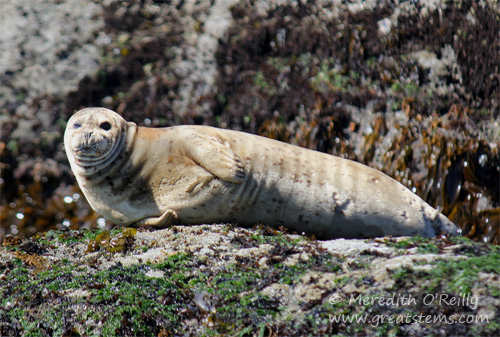 This seal was one of the last couple that remained after the other seals were frightened away. Even though at this point the first offensive people had gone, while we were looking at tide pool life, a new family had arrived, complete with a dog running loose on the beach and a child throwing a tantrum — you can see the seal was watching them with a wary eye. I’m sure that it wasn’t long before this seal finally departed for a safer, quieter environment.
This seal was one of the last couple that remained after the other seals were frightened away. Even though at this point the first offensive people had gone, while we were looking at tide pool life, a new family had arrived, complete with a dog running loose on the beach and a child throwing a tantrum — you can see the seal was watching them with a wary eye. I’m sure that it wasn’t long before this seal finally departed for a safer, quieter environment.
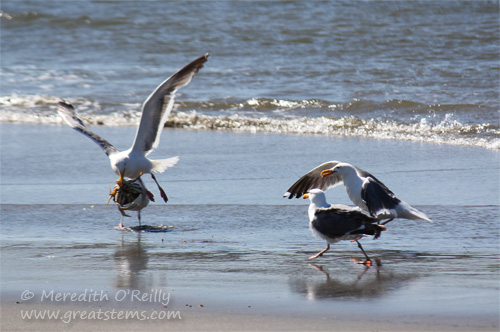
As we got ready to leave, we took a few minutes to watch gulls fight over a large dead crab. Just as one gull would dominate and declare the crab its own, another gull would sneak up from behind and drive the gull away. The process repeated again and again, reminding us of the gulls in “Finding Nemo” (Mine? Mine? Mine? Mine?). This alternating power struggle continued on for some time. Occasionally one gull would make away with a crab leg, and it proudly plucked out the bit of meat — from a safe distance.
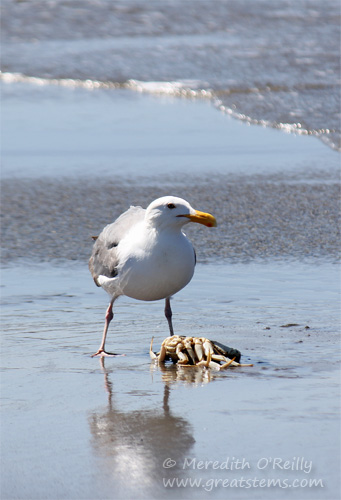
But finally one gull got the prize…
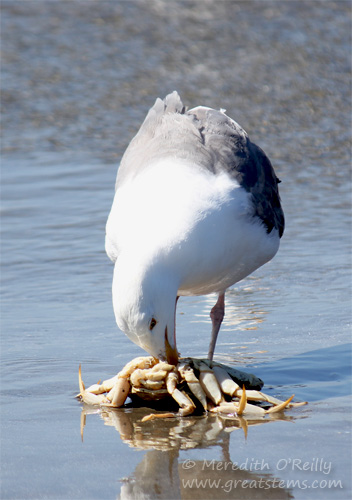
… and the feast.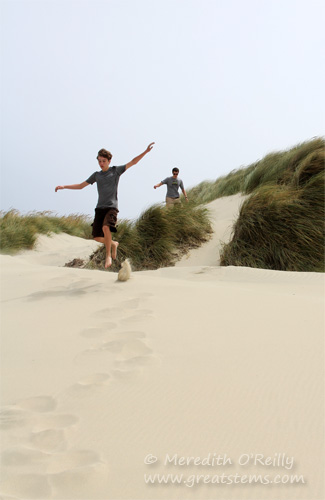 Continuing north, we stopped at an area of Oregon Dunes National Recreational Area. The dunes were tall and a blast to climb — I’d be in great shape if I could climb those every day.
Continuing north, we stopped at an area of Oregon Dunes National Recreational Area. The dunes were tall and a blast to climb — I’d be in great shape if I could climb those every day.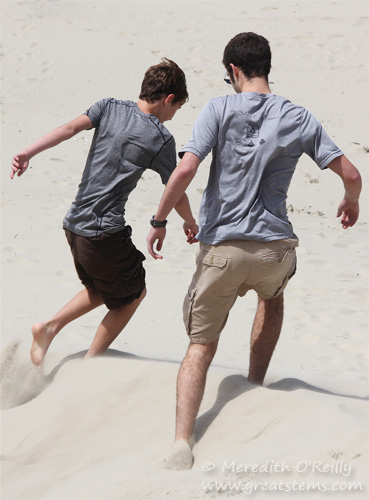 I couldn’t get the boys to roll down — they are apparently too big for that now — but they still had fun sliding, jumping, running, and chasing each other.
I couldn’t get the boys to roll down — they are apparently too big for that now — but they still had fun sliding, jumping, running, and chasing each other.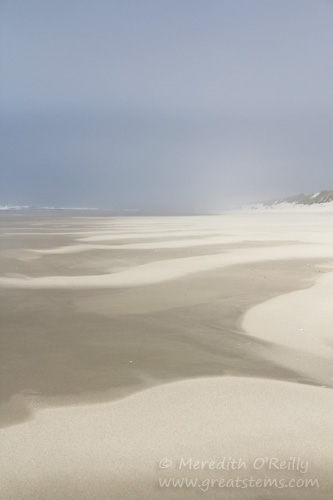 Down at the shore, the wind was impressively strong. It was easy to see how the dunes were built and shaped over time.
Down at the shore, the wind was impressively strong. It was easy to see how the dunes were built and shaped over time.
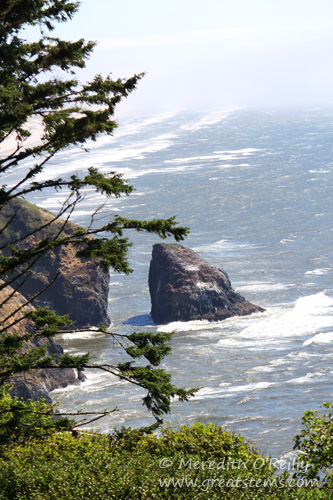 Leaving the dunes behind, we continued our northern trek, stopping just past Florence to visit the Sea Lion Caves.
Leaving the dunes behind, we continued our northern trek, stopping just past Florence to visit the Sea Lion Caves.
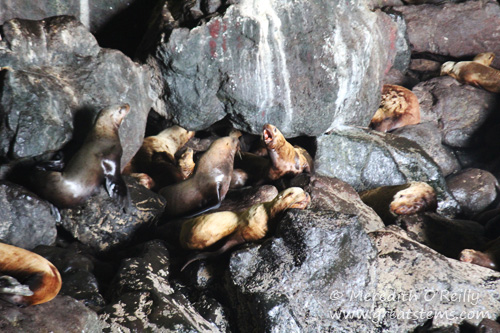
The sea-level caverns and especially the rocky areas just outside serve as a mainland rookery and haul-out area for Stellar Sea Lions and occasionally California Sea Lions. Pigeon Guillemots, Brandt’s Cormorants, gulls, and other birds also nest in the area during breeding season. I was hesitant about going at first, worried that the touristy vibe of the cave attraction would put people over wildlife, but in truth visitors watched the sea lions from a dark, sheltered viewing area — the sea lions did not appear to have any awareness of our presence. In fact, the viewing area’s elevator, built in 1961, was constructed over 3 off-seasons so the sea lions would not be present or affected in any way.
Within the cave, younger males attempted to monopolize harems. However, if hunger drove them to the sea for feeding, other males would likely take over. There was much interaction, too, between adult females and juveniles. Many of the sea lions were scarred or bleeding from waves bashing them against the rough rocks — or perhaps from fighting — but apparently this was the way of life for the sea lions.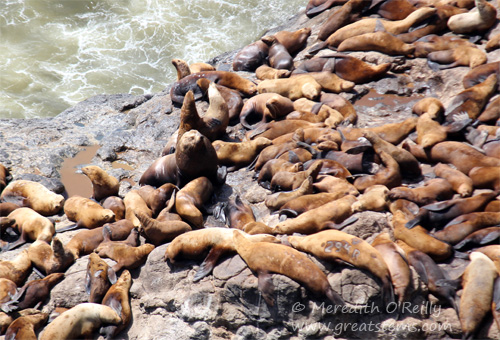
Outside and back on the cliff, a short path took us to a viewing area above the main rookery. Here, hundreds of Stellar sea lions and pups snoozed on shore. Huge bulls periodically announced their territorial control, and nearby females would occasionally lift their head with their irritated response.
A few posts ago, I mentioned that harbor seals don’t usually sleep touching each other — you can see that sea lions, on the other hand, will drape themselves all over their nearby companions as they snooze.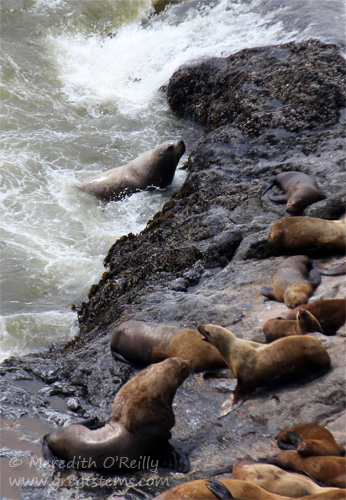
Even outside the cave, the crashing waves made it difficult for the big sea lions to haul out onto the rocks if they found themselves in the water. We watched a group of them try again and again — eventually one or two made it onto the rocks, but we left before we found out whether the rest succeeded.
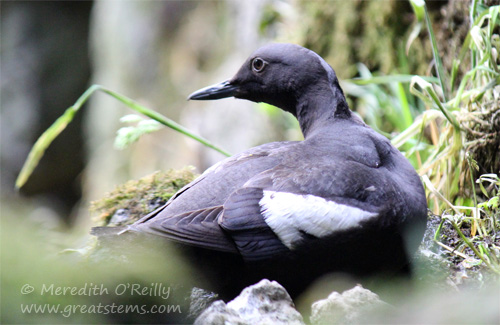
Moving back to birds, this Pigeon Guillemot rested near one of the cavern’s viewing areas. It was quite irritated by a pesky little sparrow that climbed the cliff wall above it — as the sparrow searched among the moss for insects, it dropped debris directly on the Guillemot’s head. Finally, the larger bird just gave up and moved a few feet away.
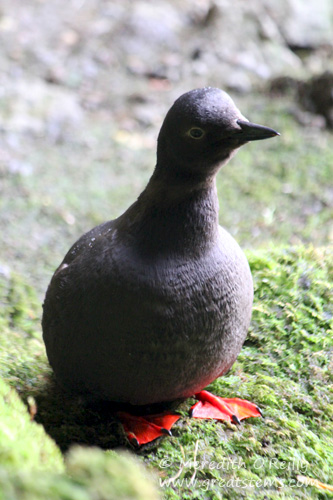
Like the Common Murre, its cousin, the Pigeon Guillemot comes to shore only to breed. However, instead of laying only one egg, the female parent lays two eggs. After breeding season, Pigeon Guillemots spend the rest of their time out on the open sea. Both Common Murres and Pigeon Guillemots are members of the auk family.
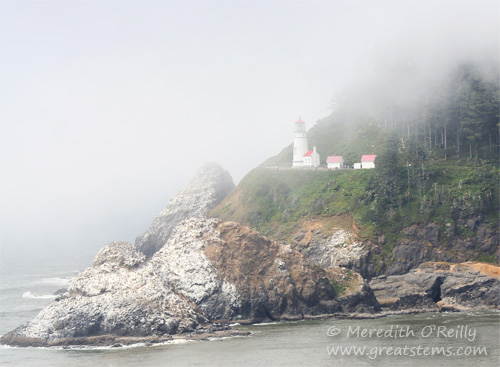 Two miles north of the caves, we pulled into an overlook to take pictures of the famous and highly-photographed Heceta Head Lighthouse. Our old vacation nemesis, fog, returned just in time to affect our pictures. Likewise, powerful wind gusts shoved against my zoom lens — it was a challenge to walk, much less take pictures.
Two miles north of the caves, we pulled into an overlook to take pictures of the famous and highly-photographed Heceta Head Lighthouse. Our old vacation nemesis, fog, returned just in time to affect our pictures. Likewise, powerful wind gusts shoved against my zoom lens — it was a challenge to walk, much less take pictures.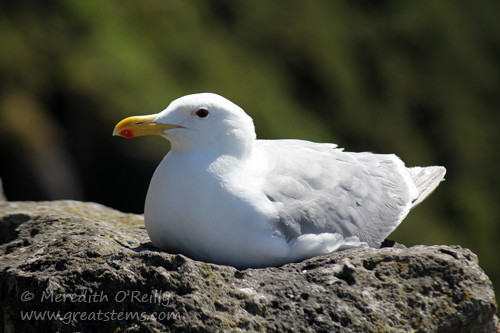 This gull and I shared moments of struggling to stand in the wind — the bird fared better when it nestled into a resting position. I had to take several pictures to ensure that at least one would be in focus, given how hard the wind shoved my camera around.
This gull and I shared moments of struggling to stand in the wind — the bird fared better when it nestled into a resting position. I had to take several pictures to ensure that at least one would be in focus, given how hard the wind shoved my camera around.
We drove on, hoping to make a bit of distance but knowing we’d need a place to camp overnight. We found an available spot at Devils Lake State Park near Lincoln City, another crowded but pleasant enough campground. The next day would be our last vacation day — alas!
Pingback: Pacific Journey: Cannon Beach, Then Home | Great Stems
Hi Meredith,
I was looking up sea stars on the west coast and found your beautiful journal. It is really stunning. I am happy to see nature looking so healthy and happy in your photos.
Just wondering what you think about the alarming reports of sea stars melting and dying on the west coast? I hope it is not as bad as the news reports say.
Thanks again for sharing your trip…the Oregon coast looks fantastic!
Diane
The situation for the sea stars is horrifying, Diane. I hope they quickly determine the cause, but no matter what it might be, it doesn’t bode well.